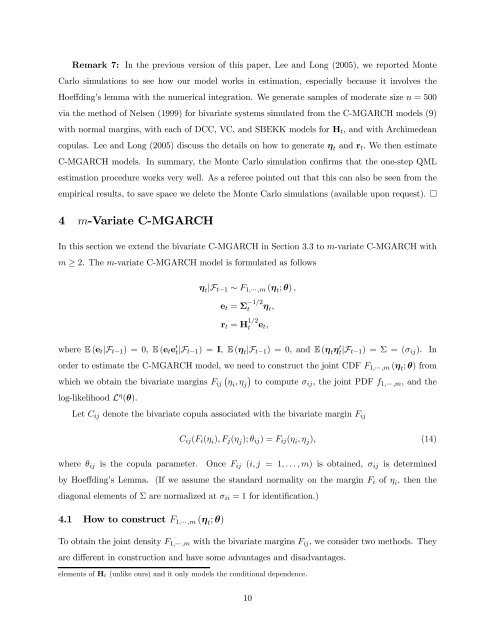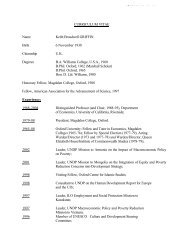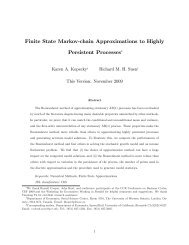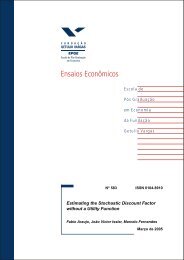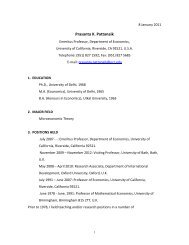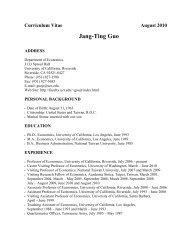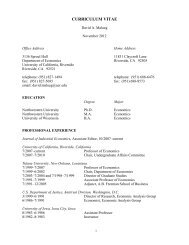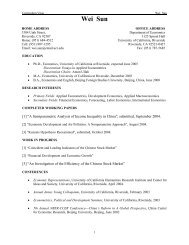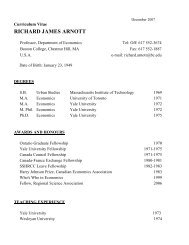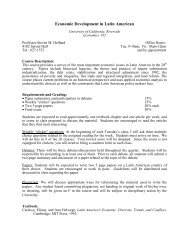Copula-based Multivariate GARCH Model with ... - Economics
Copula-based Multivariate GARCH Model with ... - Economics
Copula-based Multivariate GARCH Model with ... - Economics
You also want an ePaper? Increase the reach of your titles
YUMPU automatically turns print PDFs into web optimized ePapers that Google loves.
Remark 7: In the previous version of this paper, Lee and Long (2005), we reported Monte<br />
Carlo simulations to see how our model works in estimation, especially because it involves the<br />
Hoeffding’s lemma <strong>with</strong> the numerical integration. We generate samples of moderate size n = 500<br />
via the method of Nelsen (1999) for bivariate systems simulated from the C-M<strong>GARCH</strong> models (9)<br />
<strong>with</strong> normal margins, <strong>with</strong> each of DCC, VC, and SBEKK models for H t , and<strong>with</strong>Archimedean<br />
copulas. Lee and Long (2005) discuss the details on how to generate η t and r t . We then estimate<br />
C-M<strong>GARCH</strong> models. In summary, the Monte Carlo simulation confirms that the one-step QML<br />
estimation procedure works very well. As a referee pointed out that this can also be seen from the<br />
empirical results, to save space we delete the Monte Carlo simulations (available upon request). ¤<br />
4 m-Variate C-M<strong>GARCH</strong><br />
In this section we extend the bivariate C-M<strong>GARCH</strong> in Section 3.3 to m-variate C-M<strong>GARCH</strong> <strong>with</strong><br />
m ≥ 2. Them-variate C-M<strong>GARCH</strong> model is formulated as follows<br />
η t |F t−1 ∼ F 1,··· ,m (η t ; θ) ,<br />
e t = Σ −1/2<br />
t η t ,<br />
r t = H 1/2<br />
t e t ,<br />
where E (e t |F t−1 )=0, E (e t e 0 t|F t−1 )=I, E (η t |F t−1 )=0,andE (η t η 0 t|F t−1 )=Σ =(σ ij ). In<br />
order to estimate the C-M<strong>GARCH</strong> model, we need to construct the joint CDF F 1,··· ,m (η t ; θ) from<br />
which we obtain the bivariate margins F ij<br />
¡<br />
ηi ,η j<br />
¢<br />
to compute σij , the joint PDF f 1,··· ,m , and the<br />
log-likelihood L η (θ).<br />
Let C ij denote the bivariate copula associated <strong>with</strong> the bivariate margin F ij<br />
C ij (F i (η i ),F j (η j ); θ ij )=F ij (η i ,η j ), (14)<br />
where θ ij is the copula parameter. Once F ij (i, j = 1,...,m) is obtained, σ ij is determined<br />
by Hoeffding’s Lemma. (If we assume the standard normality on the margin F i of η i , then the<br />
diagonal elements of Σ are normalized at σ ii =1for identification.)<br />
4.1 How to construct F 1,··· ,m (η t ; θ)<br />
To obtain the joint density F 1,··· ,m <strong>with</strong> the bivariate margins F ij , we consider two methods. They<br />
are different in construction and have some advantages and disadvantages.<br />
elements of H t (unlike ours) and it only models the conditional dependence.<br />
10


